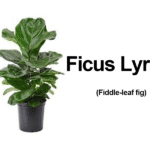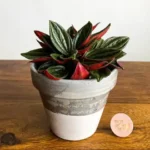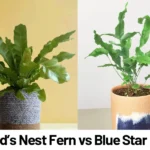ZZ Plant vs Peace Lily: What’s the Difference and Which Should You Choose?
ZZ Plant (Zamioculcas zamiifolia) and Peace Lily (Spathiphyllum spp.) are two of the most popular indoor plants for beginner gardeners—and it’s easy to see why. Both flourish in indoor settings, tolerate low light, and have sleek green foliage that adds life and elegance to homes and workspaces. However, despite their shared use and appearance at a glance, they come from completely different plant families and have very different care needs and aesthetic qualities.
Many indoor plant lovers often confuse the ZZ Plant and Peace Lily, especially when shopping for a hardy low-light plant that doesn’t require a lot of attention. Yet the differences are significant and can affect how well the plant fits your space and lifestyle. This side-by-side comparison helps demystify the differences and highlights what makes each plant unique, so you can make an informed choice that suits your needs.
ZZ Plant vs Peace Lily: Quick Comparison Table
| Feature | ZZ Plant | Peace Lily |
|---|---|---|
| Botanical Name / Family | Zamioculcas zamiifolia / Araceae | Spathiphyllum wallisii (common species) / Araceae |
| Native Region | Eastern Africa (Kenya to South Africa) | Tropical Americas (Colombia to Venezuela) |
| Leaf Shape & Size | Glossy, thick, oval-shaped leaflets (4–6 inches long) | Pointed, soft lance-shaped leaves (6–12 inches long) |
| Growth Habit & Speed | Slow-growing, upright; grows 2–3 ft tall | Moderate growth rate; bushy, arching; grows 1–3 ft tall |
| Stem Structure / Key Identifier | Thick rhizomes; firm upright stems | No true stems; leaves emerge from base |
| Light Requirements | Low to bright indirect light (100–2,500 lux) | Medium to bright indirect light (500–3,000 lux) |
| Watering & Humidity | Water every 2–3 weeks; prefers 30–50% humidity | Keep soil slightly moist; prefers 50–70% humidity |
| Pet Safety / Toxicity | Toxic to cats, dogs, and humans if ingested | Toxic to cats and dogs (calcium oxalate) |
| Availability / Price | Widely available; $20–40 depending on size | Very common; $10–25 depending on size |
Major Differences Explained
1. Visual Identity & Aesthetic Appeal
Though both plants have strong visual appeal, their foliage differs significantly when viewed up close. The ZZ Plant showcases shiny, waxy, dark green leaves arranged symmetrically along thick upright stems, giving it a structured, almost sculptural form. This glossy texture and low profile make it a favorite in modern and minimalist spaces.
In contrast, the Peace Lily features softer, larger, more delicate leaves that arch and cascade outward, providing a fuller, more lush appearance. It also develops iconic white flowers called spathes that resemble calla lilies—an ornamental bonus the ZZ Plant doesn’t offer. These blooms can appear several times a year under good conditions, adding seasonal visual interest.
2. Growth Habit and Space Considerations
ZZ Plants are upright growers that remain compact for a long period, reaching a mature size of just 2–3 feet tall and wide over several years. Their slow growth and tidy form make them ideal for desks, bookshelves, or tight corners where a neat look is desired. Peace Lilies, by contrast, expand more quickly and spread outward from the base, requiring more floor or table space over time. Their leaves naturally droop and take up more visual volume.
3. Watering Needs and Tolerance
One of the biggest practical differences is moisture tolerance. ZZ Plants are drought-tolerant thanks to their subterranean rhizomes that store water. They are happiest when watered infrequently—every 2 to 3 weeks—and they can survive low humidity environments just fine (as low as 30%). This makes the ZZ almost impossible to overwater if you tend to forget watering routines.
The Peace Lily, on the other hand, prefers its soil to stay lightly moist and will dramatically wilt when it dries out too much, bouncing back quickly when watered. It thrives in higher humidity (ideally 50–70%), making it a bit higher maintenance, especially in dry indoor environments like heated winter apartments.
4. Lighting Conditions and Adaptability
Both plants do well in low to moderate indoor light, but here too, their preferences diverge. ZZ Plants are incredibly adaptable and can tolerate lower light levels (as low as 100 lux) better than almost any indoor plant. This gives them a key advantage in windowless offices, hallways, or dim spaces.
Peace Lilies prefer medium to bright indirect light (around 500–3,000 lux) if you want them to bloom. While they tolerate medium light, consistent lower light will suppress flowering and slow overall growth. Their leaves also tend to yellow or droop in extreme low-light conditions.
Which One Should You Choose?
Selecting between the ZZ Plant and the Peace Lily will depend largely on your environment, care habits, and aesthetic preference. Here are some factors to help guide your choice:
Best for Beginners: ZZ Plant is more forgiving and lower maintenance. It’s excellent for those who are just getting started with plant care or tend to forget watering.
Best for Low Light Homes or Offices: ZZ Plant handles extremely low light better and is more tolerant of neglect.
Best for a Lush, Blooming Display: Peace Lily offers dramatic foliage and white spathed flowers, perfect for a living room centerpiece or entryway statement.
Best for High Humidity Environments: If you live in a naturally humid area or use a humidifier, Peace Lily responds well with fuller growth and blooms.
Best for Small Apartments or Tight Spaces: ZZ Plant’s vertical silhouette makes it perfect for small surfaces and minimal interiors.
Best for Pet-Friendly Homes: Unfortunately, neither plant is truly pet-safe if ingested. However, ZZ Plants tend to be less attractive to curious pets due to their bitter taste and tougher foliage. Still, pet owners should exercise caution with either plant.
Conclusion
ZZ Plants and Peace Lilies are both excellent indoor greenery options, but each brings its own strengths and challenges. ZZ Plants win on low-maintenance hardiness and architectural charm, while Peace Lilies shine in lush foliage and elegant flowering. Neither is particularly demanding, but your home’s light level, humidity, available space, and time for care will largely dictate which one is better for your situation.
When in doubt, consider starting with a ZZ Plant if you’re a forgetful waterer or dealing with a darker room. Opt for a Peace Lily if you can provide steady moisture and want the added beauty of blooms. Whichever you choose, both plants reward your care with long-lasting vitality and beauty indoors.
References
- Gilman, E. F., & Watson, D. G. (1993). Spathiphyllum wallisii: Peace Lily. University of Florida IFAS Extension. https://edis.ifas.ufl.edu/pdf%5CES%5CES03900.pdf
- University of Wisconsin–Madison Division of Extension. (n.d.). Zamioculcas zamiifolia (ZZ Plant). https://hort.extension.wisc.edu/articles/zamioculcas-zamiifolia-zz-plant/
- ASPCA. (n.d.). Toxic and Non-Toxic Plants List. American Society for the Prevention of Cruelty to Animals. https://www.aspca.org/pet-care/animal-poison-control/toxic-and-non-toxic-plants








